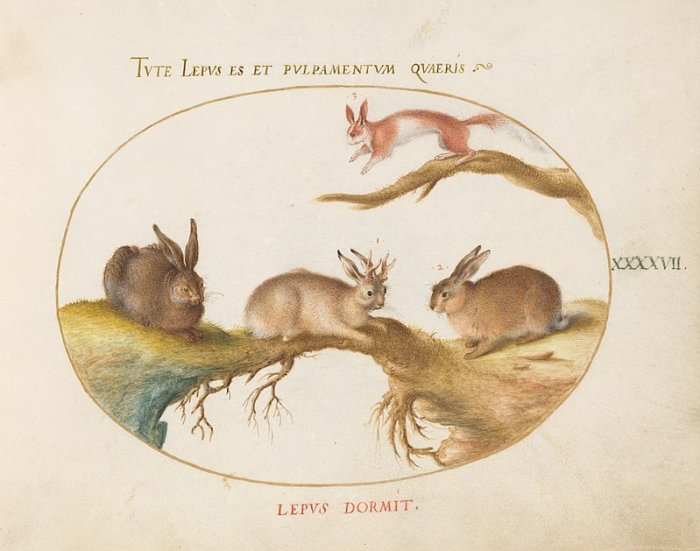Jackalope – Are Mythical Horned Hares Real?
Ellen Lloyd - AncientPages.com - The jackalope is a mythical animal that many people claim to have seen in modern times. Do these horned hares really exist or are they just a myth? Why do so many people claim to have spotted the jackalope? What could be the truth behind these reported sightings?
Horned Animals Plate XLVII of Animalia Qvadrvpedia et Reptilia (Terra) by Joris Hoefnagel, circa 1575, showing a "horned hare". Credit: Public Domain And Other Beings In Mythology
Tales of the jackalope have been circulating for centuries. Many legends of this unusual animal come from America, but stories of horned hares have been known by many ancient cultures worldwide. In North American folklore, the jackalope is a jackrabbit with antelope horns. In Central America, mythological references to a horned rabbit creature can be found in Huichol legends. In ancient Persia people spoke about a rabbit with one horn, similar to the famous Unicorn that is mentioned seven times in the Bible, but only by mistake. The Biblical unicorn was actually an onyx.
Vikings also managed to fool Europeans with their unicorn bluff for hundreds of years. They started selling a narwhal’s tooth claiming it was a unicorn horn. In Germany, “the horned hare often has other strange body parts (wings and beaks) and is called the Wolpertinger (in Bavaria, southern Germany) or the Rasselbock (in Thuringia, central Germany)". (Nancy Jennings -RSPB Spotlight Hares).
Vikings’ Unicorn Bluff Fooled Europeans For Hundreds Of Years - Read more
Many myths of our ancestors tell of various horned animals and other beings. Known under different names, the horned serpent has been encountered in North America, Egypt, Mesopotamia and Europe. In Europe we encounter several mythological beings who were believed to have had horns.
Cernunnos, a god in Celtic mythology that possessed two deer antlers on the top of his head. Herne the Hunter, a mysterious, mythical creature who was said to reside in Windsor Forest and Great Park in the English county of Berkshire had also horns.
Cernunnos, Celtic horned god. Image credit: Wikipedia
According to our ancestors, horns represented the primal power of nature, expressed the unstoppable power and the majesty and throughout human history. Because of this, horns have been synonymous with strength, and they became a universal ancient symbol.
For example, Cornucopia, the ‘Horn Of Plenty’ is a symbol of wealth, abundance, fertility and nourishment, highly respected by many ancient cultures including the Celts, whose concept of abundance was main part of their religion. Many of us have a cornucopia at home; it can be made of plastic, wicker, metal, wood or other materials. It can be symbolically filled with something valuable or simply beautiful.
One can say that the ancient worship of horns has survived. We don’t think about it, but when we look around, we can clearly see there are many objects and symbols that remind us of our ancestors’ deep respect for horns.
How The Jackalope Became Very Famous
Knowledge of the jackalope spread and the horned rabbit suddenly appeared in Medieval paintings. During the Renaissance, and later scientists started to debate whether this creature could be a genuine biological species. At the end of the 18th century, most scholars rejected the idea that horned rabbits could be more than mythological animals.
It was Douglas Herrick (1920–2003) a Wyoming resident who made the jackalope really famous. In 1932, while returning from a hunting trip he tossed a carcass onto the floor, where it came to rest beside a pair of deer antlers. As a taxidermist this gave him an idea that he put to action. Together with his son he started to produce jackalope mounts.
Jackalope Square, 211 West Center street, Douglas, Wyoming, featuring iconic fiberglass Jackalope. Credit: Montanabw, Wikipedia, CC BY-SA 4.0
Before passing away at the age of 82, he and his son had made thousands of jackalope mounts. Douglas Herrick earned a lot by selling his jackalope mounts, but his “work” was just a hoax. People embraced this animal as a symbol of the West. The jackalope appeared on postcards, brochures and Wyoming became known as the “Jackalope Capital of the World.” Curious people came to catch a glimpse of this rare animal, but one cannot search for something that is unreal.
In 2005, Wyoming legislators declared the jackalope as the state’s “Official Mythical Creature.”
Are Jackalopes Real – Why Have So Many Seen Them?
The fact that the jackalope is today considered a mythical creature hasn’t put an end to the sightings of the horned hares. Witness say they have seen antlered species of rabbit that are brownish in color. The animal is believed to weight about three to five pounds, and it can move at a remarkable speed up to 90 miles per hour.
Does this mean that the jackalope really exist? The answer to this question is yeas and no.
See also:
Cannibalistic Shapeshifter Wendigo In Myths And Legends Of The Indians Of North America And Canada
Surprising End To Legend Of The Snallygaster That Terrorized Maryland And Washington
It cannot be denied that some real rabbits do indeed sprout horn-shaped growths from their heads, but this condition is triggered by a virus called papillomatosis. Over the years many people claim to have seen the jackalope, but not everything is always what it seems.
Unfortunately, behind many of these alleged sightings we find a combination of hoax and media activity. Several people have used this mythical creature to seek financial gain. According to scientists there is no solid, physical evidence of a jackalope as described by our ancestors. Nevertheless, occasionally people keep reporting sightings of this rare animals and many are still convinced it does exist, and the legends told around the campfire are being kept alive.
Written by Ellen Lloyd – AncientPages.com
Copyright © AncientPages.com All rights reserved. This material may not be published, broadcast, rewritten or redistributed in whole or part without the express written permission of AncientPages.com
Expand for referencesMore From Ancient Pages
-
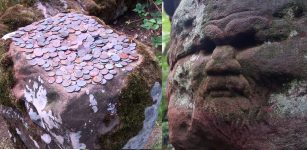 Dunino Den: Mysterious And Sacred Ancient Site In Scotland With Enigmatic Rock Faces And Symbols
Featured Stories | Jan 6, 2017
Dunino Den: Mysterious And Sacred Ancient Site In Scotland With Enigmatic Rock Faces And Symbols
Featured Stories | Jan 6, 2017 -
 Accidental Discovery Of Large Trove Of 14th Century Gold And Silver Coins In West Bohemia
Archaeology | Aug 13, 2020
Accidental Discovery Of Large Trove Of 14th Century Gold And Silver Coins In West Bohemia
Archaeology | Aug 13, 2020 -
 Biblical Mystery Of The Forbidden Fruit And The ‘Deep Sleep’
Ancient Mysteries | Feb 13, 2022
Biblical Mystery Of The Forbidden Fruit And The ‘Deep Sleep’
Ancient Mysteries | Feb 13, 2022 -
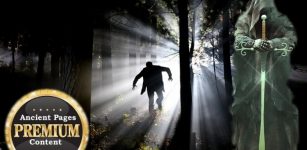 Danger Lurking In The Woods – Mysterious Vanishings, Deaths And Unusual Behavior – Part 3
Featured Stories | Jul 9, 2018
Danger Lurking In The Woods – Mysterious Vanishings, Deaths And Unusual Behavior – Part 3
Featured Stories | Jul 9, 2018 -
 Secrets Of The Japanese Shirasaya Sword Mounting
Featured Stories | Sep 11, 2018
Secrets Of The Japanese Shirasaya Sword Mounting
Featured Stories | Sep 11, 2018 -
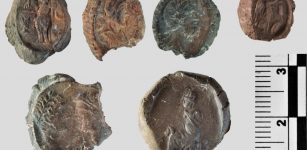 1,000 Ancient Sealings Linked To Graeco-Roman Pantheon Among Finds In Unidentified Church In Turkey
Archaeology | Dec 12, 2017
1,000 Ancient Sealings Linked To Graeco-Roman Pantheon Among Finds In Unidentified Church In Turkey
Archaeology | Dec 12, 2017 -
 1,700-Year-Old Vase For Olive Oil And Wine Unearthed At Historic Site Of Diyarbakir Fortress, Turkey
Archaeology | Aug 5, 2022
1,700-Year-Old Vase For Olive Oil And Wine Unearthed At Historic Site Of Diyarbakir Fortress, Turkey
Archaeology | Aug 5, 2022 -
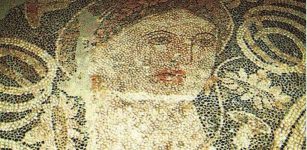 Wax Tablets Reveal Ancient Secrets of The Illyrians
Artifacts | Sep 5, 2015
Wax Tablets Reveal Ancient Secrets of The Illyrians
Artifacts | Sep 5, 2015 -
 Mystery Of The Giant Laos Jars Continues – New Discoveries Reported By Scientists
Archaeology | Apr 19, 2021
Mystery Of The Giant Laos Jars Continues – New Discoveries Reported By Scientists
Archaeology | Apr 19, 2021 -
 Calakmul Was Powerful Ancient Maya Seat Of The Snake Kingdom
Featured Stories | Apr 15, 2019
Calakmul Was Powerful Ancient Maya Seat Of The Snake Kingdom
Featured Stories | Apr 15, 2019 -
 Mystery Of The Ashkenazi Jews Found In A Medieval Mass Burial – Solved!
Archaeology | Aug 30, 2022
Mystery Of The Ashkenazi Jews Found In A Medieval Mass Burial – Solved!
Archaeology | Aug 30, 2022 -
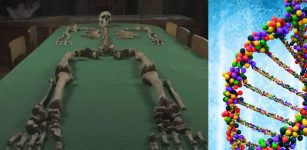 DNA Reveals Stone Age People Avoided Inbreeding
DNA | Mar 9, 2024
DNA Reveals Stone Age People Avoided Inbreeding
DNA | Mar 9, 2024 -
 Unusual 2,500-Year-Old Face Urns Reveal Garments, Appearance And Jewelry Of Prehistoric People
Archaeology | Nov 11, 2017
Unusual 2,500-Year-Old Face Urns Reveal Garments, Appearance And Jewelry Of Prehistoric People
Archaeology | Nov 11, 2017 -
 Egyptian Priest Sonchis Of Sais And His Story About Atlantis – Were The Shemsu Hor Survivors Of A Great Catastrophe That Ended The Ice Age?
Ancient Mysteries | Jun 8, 2017
Egyptian Priest Sonchis Of Sais And His Story About Atlantis – Were The Shemsu Hor Survivors Of A Great Catastrophe That Ended The Ice Age?
Ancient Mysteries | Jun 8, 2017 -
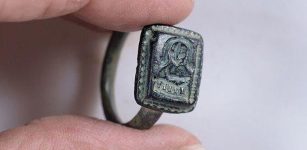 Ancient Bronze Ring Bearing The Image Of St. Nicholas May Have Been Worn For Protection
Archaeology | Dec 28, 2021
Ancient Bronze Ring Bearing The Image Of St. Nicholas May Have Been Worn For Protection
Archaeology | Dec 28, 2021 -
 7,000-Year-Old Native American Underwater Burial Site Discovered Off The Coast Of Florida
Archaeology | Mar 3, 2018
7,000-Year-Old Native American Underwater Burial Site Discovered Off The Coast Of Florida
Archaeology | Mar 3, 2018 -
 Mystery Of The Ancient Okunev Culture: Skeleton Of 4,500-Year-Old Noblewoman With Links To Native Americans Discovered In Siberia
Archaeology | Sep 9, 2016
Mystery Of The Ancient Okunev Culture: Skeleton Of 4,500-Year-Old Noblewoman With Links To Native Americans Discovered In Siberia
Archaeology | Sep 9, 2016 -
 Largest Ever Human Family Tree: 27 Million Ancestors Mapped
Archaeology | Feb 25, 2022
Largest Ever Human Family Tree: 27 Million Ancestors Mapped
Archaeology | Feb 25, 2022 -
 Advanced Ancient Technology – Talos A Greek Robot Created By The God Of The Forge
Featured Stories | Jun 28, 2014
Advanced Ancient Technology – Talos A Greek Robot Created By The God Of The Forge
Featured Stories | Jun 28, 2014 -
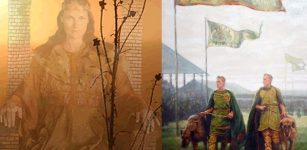 Tailteann Games: Ancient Irish Version Of The Olympic Games
Ancient History Facts | May 15, 2016
Tailteann Games: Ancient Irish Version Of The Olympic Games
Ancient History Facts | May 15, 2016

